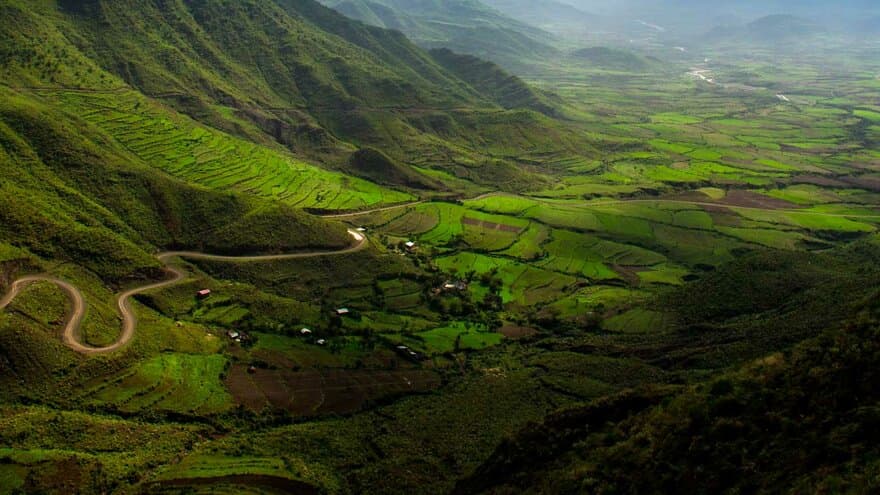Digitisation has drastically reduced the costs involved in registering owners of cultivated land. This has made large-scale land registration, which in particular strengthens women's rights in societies where they have a weak position, more relevant for developing countries.
Land registration generally describes systems by which matters concerning ownership, possession or other rights in land are recorded (usually with a government agency or department) to provide evidence of title, facilitate transactions and to prevent unlawful disposal.
Can measure the effect of land registration on child health
In countries such as Ethiopia land registration shows that there is a difference between farms run by men and women, and provides the opportunity to measure the quantitative effect of land reforms.
This also makes it possible to tell whether a specific reform has had a positive effect on women's rights, or whether a land reform has affected children's health in agricultural households with different types of owners.
"With our data, combining land registration data and household survey data, we can, for example, measure the effect of land registration on the Body Mass Index of children, and assess whether there is a difference between households headed by women or men. We have found a positive effect of land registration on children's Body Mass Index, and it is greater in female-headed households than in male-headed households," says Stein Holden.
He is professor in Development and Resource Economics in the School of Economics and Business at Norwegian University of Life Sciences (NMBU).
The first study of its kind
Together with associate professor Mesfin Tilahun he recently published the first study of its kind that in detail examines the distribution of men's and women's documented rights to agricultural land in Africa. It is based on two land registry and certification reforms in Ethiopia.
In agrarian based economies where population density have continued to increase, land scarcity has increased. At the same time land as a source of livelihood remains crucial for large populations - e.g. in Sub-Saharan Africa. There is a close correlation between land holdings and the level of poverty in such economies.
This makes documenting the rights to manage agricultural property extra important.
In Ethiopia, all rural residents without other means of livelihood enjoy a constitutional right granting access to agricultural land in order to ensure a livelihood. However, the population growth has made this right increasingly difficult to satisfy, and redistribution of land has created tenure insecurity.

Specifically strengthens women's rights
The first land registration and certification reform was implemented in Ethiopia in 1998 based on a new land law and has been described as the largest, fastest and most cost-effective land registration and certification reforms in Africa.
Several studies have described how the reform increased tenure security to agricultural land. Female-headed households benefitted especially from the the improved tenure security provided by legal written documents in the form of land certificates. With the reforms the country obtained its own registry of who owned what area.
"The position of women in Ethiopia was weak to begin with, consequently better documentation of owner's rights to land has had a bigger impact for women than for men," Holden explains.
For many women, proof of land ownership can end years of economic uncertainty, vulnerability, and fear.
"For women, the increased security concerning their own legal position has made them feel safer, which again has made women more likely to invest in the land and more able to rent out their land through sharecropping contracts. For example, they have been able to lease land to good farmers with oxen and get half of the crop output from these farmers, thereby improving food security and the children's nutrition. Better documentation of land tenure rights have also made it easier for women to lease out land to those who pay best, and not just to family," Holden says.
However, this first reform was to a great degree a reform without modern technology. The registration was recorded in handwritten registration books, making it difficult and cumbersome to update records. Moreover, these paper-based records were not easily accessible for administrative purposes such as planning and policy analysis.
From paper to GPS, satellite images and aerial photography
Holden and Tilahun's new study compares data from the reform in 1998 using simple technologies with a new reform in 2016 using modern technology.
As a result, they can also document the impact of new technology on land registration and certification since the most recent reform was carried out with satellite imagery, GPS and aerial photos as the basis for mapping. This was then combined with field verification of borders and land right holders, and the holders receive parcel-level certificates with maps showing their land – creating a new set of digital public registration data.
The aim of this technological upgrade is, among other things, to strengthen the security of land tenure and to establish land registries that are easier to maintain and update.
"New technology has made land registration significantly cheaper than previously, and it has lowered the threshold for developing countries to implement this type of reform since costs have fallen so drastically," says Holden.
In Ethiopia, this modern registration method costs around eight US dollars per parcel of land. Classic land registration cost several hundred US dollars and was simply too expensive for smallholder farmers.
However, farmers are not charged for the registration/certification costs in Ethiopia. The state covers the cost partly with help from foreign donors, but the cost reduction lowers the threshold for similar registration and certification in other developing countries. This will also facilitate measurement and monitoring of some of the new Sustainable Development Goals that recently replaced the Millennium Development Goals.
A surprising amount of land owned by women
The new registry data are also more detailed than the old ones. The new data allows the researchers to see the gender of all land owners. Each parcel of land can have many owners. It is possible to assess the distribution of land among women, among men, between women and men, and the variation in gender-distribution of land within households.
In the latest land registry and certification reform in 2016, women owned as much as 48.8 percent of all privately held agricultural land in the area that the researchers studied in the Tigray region in northern Ethiopia.
Male-headed households owned on average 34 percent more land than female-headed households, but this difference was reduced to less than 10 percent after correcting for differences in in family sizes between these households.
Using land registry data gathered in 2016, researchers analysed the degree of inequality in land distribution for 31,150 households in four districts for nearly 80,000 registered parcels of land, each with up to 8 owners. In the dataset one can see the differences in ownership distribution in female-headed versus male-headed households, the inequalities between households within the communities, within districts and gender-based distribution of land within households, within male-headed households, and within female-headed households.
Reference: Holden, S.T. and Tilahun, M. (2017):«Land Distribution in Northern Ethiopia from 1998 to 2016: Gender-disaggregated, Spatial and Intertemporal Variation»
Read the full Norwegian version of this article, and see video, here.
